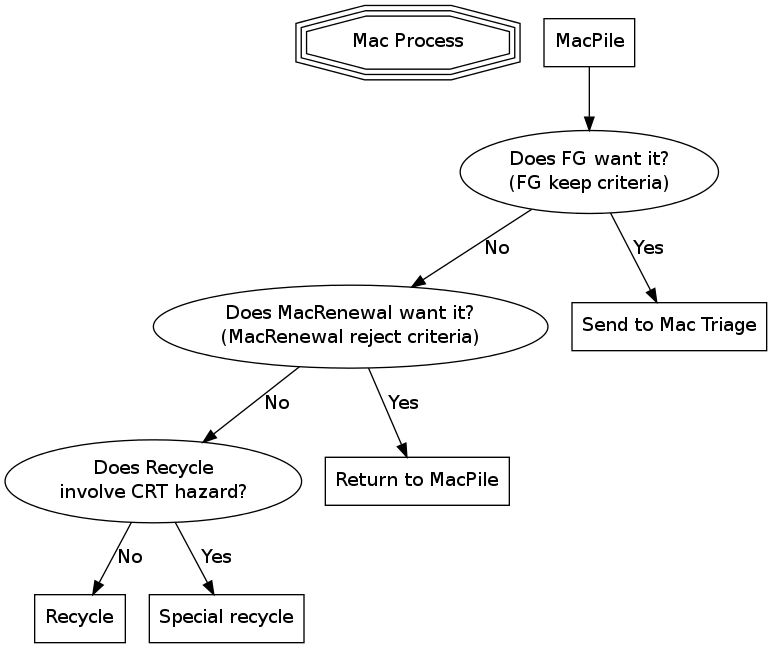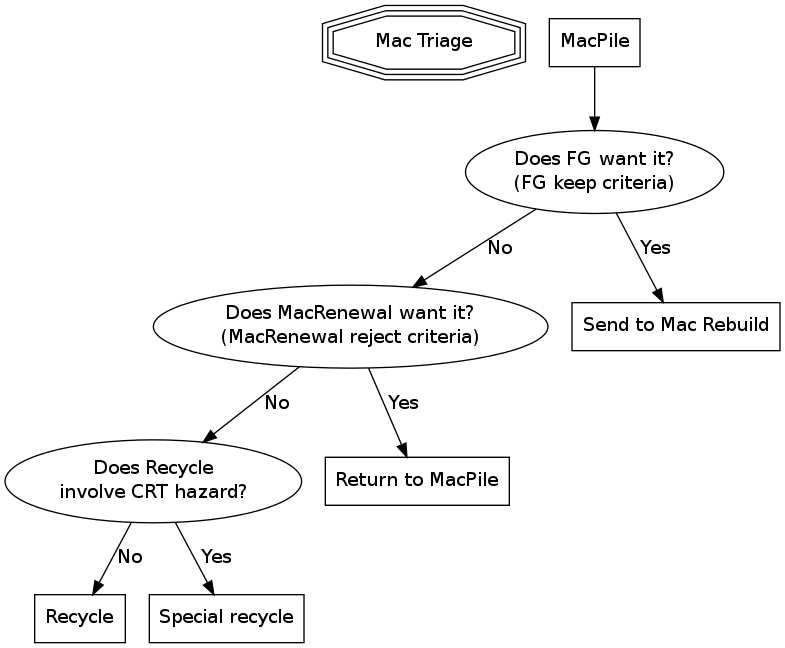Difference between revisions of "Tonys Mac Page"
Jump to navigation
Jump to search
(Move my stuff from Mac page to here) |
(Moved my rambings from Mac page to here) |
||
| Line 1: | Line 1: | ||
| − | I | + | (I have moved all of my development stuff from [[Mac]] to here. There is a link there |
| − | back to here. | + | back to here. -tr 1jan07) |
| − | |||
| − | |||
| − | |||
| − | |||
| − | |||
| − | |||
| − | |||
| − | |||
| − | |||
| − | |||
| − | |||
| − | |||
| − | |||
| − | |||
| − | |||
| Line 24: | Line 9: | ||
* Expand HW knowledge in Programs | * Expand HW knowledge in Programs | ||
* ??? | * ??? | ||
| + | |||
'''Constraints''' | '''Constraints''' | ||
| Line 29: | Line 15: | ||
* Few knowledgeable volunteers | * Few knowledgeable volunteers | ||
* CRT hazard in recycle | * CRT hazard in recycle | ||
| + | |||
'''To Do:''' | '''To Do:''' | ||
| Line 37: | Line 24: | ||
* Decide about mining from slot loaders (under the cutoff) destined for MacRenewal | * Decide about mining from slot loaders (under the cutoff) destined for MacRenewal | ||
* Add suggestion for freegeek mac acceptance criteria | * Add suggestion for freegeek mac acceptance criteria | ||
| + | |||
| + | |||
| + | '''What are we building: an iMac or a Linux box?''' | ||
| + | * There seems to be some thought in the community that the rebuilt iMacs should retain an Apple Mac personality: hardware configuration should match the original label, one-button mouse, etc. I have a some of arguments against this. | ||
| + | |||
| + | ** 1. Rebuilt iMac boxes are already have a significantly different hardware configuration than is indicated on any label. Ubuntu installation requires/suggests 256MB of ram; the labels we see say 32MB, 64MB, or 128MB. Many iMacs that we see have hard drives that are 4GB or 6GB. Those are being replaced with 10-15GB drives. | ||
| + | |||
| + | ** 2. Macs that arrive may already have been upgraded with larger drives and/or more memory. The suggested practice of retaining those configurations, or trying to match label configurations, has led to the suggestion to test memory and hard drives in place. Testing in place adds several hours to the Mac Eval/Build process. It would be more efficient, and more in keeping with the existing build process, to remove all memory and hard drives, send them to Advanced Testing, and replace them from the tested memory and hard drive stacks to produce a standard store configuration. | ||
| + | |||
| + | ** 3. The Mac 'personality' is a combination of hardware, Mac OS, Mac software, and Mac UI. The installation of Linux replaces three of the four parts. With the exception of the way the box looks, the Mac personality is gone. | ||
| + | |||
| + | ** 4. The Mac OS 9 (and OS X ?) UI is tailored to a one-button mouse. The Linux/Ubuntu UI expects a two-button or three button mouse. Getting at the 2-3 button functionality of the Ubuntu UI is awkward at best with a one-button mouse. | ||
| + | |||
| + | * My contention is that we are rebuilding the Macs to be, for the moment, Freegeek Store Linux Boxes. They should be configured as a standard low-end store box with 256MB, 10-15G HD, and a 3-button mouse. This approach allows for a better use of the existing triage/test/build process. | ||
Revision as of 19:13, 1 January 2007
(I have moved all of my development stuff from Mac to here. There is a link there back to here. -tr 1jan07)
Drivers
- Unused available hardware
- Contribute to revenue stream
- Expand HW knowledge in Programs
- ???
Constraints
- Storage space limitation
- Few knowledgeable volunteers
- CRT hazard in recycle
To Do:
- Flesh out Mac Rebuild section
- Rework MacPile/Triage relationship (currently MacPile is Triage Entry and MacRenewal Pickup)
- Distinguish between iMac 'bubble' boxes and Towers during Triage
- Can/Should rejected Towers be recycled by FG?
- Decide about mining from slot loaders (under the cutoff) destined for MacRenewal
- Add suggestion for freegeek mac acceptance criteria
What are we building: an iMac or a Linux box?
- There seems to be some thought in the community that the rebuilt iMacs should retain an Apple Mac personality: hardware configuration should match the original label, one-button mouse, etc. I have a some of arguments against this.
- 1. Rebuilt iMac boxes are already have a significantly different hardware configuration than is indicated on any label. Ubuntu installation requires/suggests 256MB of ram; the labels we see say 32MB, 64MB, or 128MB. Many iMacs that we see have hard drives that are 4GB or 6GB. Those are being replaced with 10-15GB drives.
- 2. Macs that arrive may already have been upgraded with larger drives and/or more memory. The suggested practice of retaining those configurations, or trying to match label configurations, has led to the suggestion to test memory and hard drives in place. Testing in place adds several hours to the Mac Eval/Build process. It would be more efficient, and more in keeping with the existing build process, to remove all memory and hard drives, send them to Advanced Testing, and replace them from the tested memory and hard drive stacks to produce a standard store configuration.
- 3. The Mac 'personality' is a combination of hardware, Mac OS, Mac software, and Mac UI. The installation of Linux replaces three of the four parts. With the exception of the way the box looks, the Mac personality is gone.
- 4. The Mac OS 9 (and OS X ?) UI is tailored to a one-button mouse. The Linux/Ubuntu UI expects a two-button or three button mouse. Getting at the 2-3 button functionality of the Ubuntu UI is awkward at best with a one-button mouse.
- My contention is that we are rebuilding the Macs to be, for the moment, Freegeek Store Linux Boxes. They should be configured as a standard low-end store box with 256MB, 10-15G HD, and a 3-button mouse. This approach allows for a better use of the existing triage/test/build process.
Here is first cut at an overview
Overview

FG Keep Criteria
- FG Mac lowend cutoff
- Mac Triage storage available
MacRenewal Reject Criteria
- (Lorraine's rejection list goes here)
Special Recycle
- Requires special training to avoid CRT flyback transformer hazard
- Carcass sent to Monitor Recycle
Mac Triage

Notes
- Mac Triage should maintain a pool of good memory sticks (64MB will do), small hard drives, good batteries
- Should we mine PPC cpu's? Wouldn't this require some kind of Advanced Testing support?
- Should we mine memory and hard drive as a matter of course on good boxes?
- Should any hard drive or memory be tested in place?
Mac Rebuild
